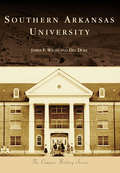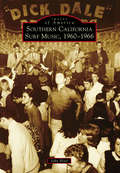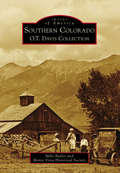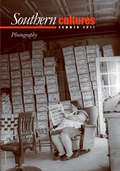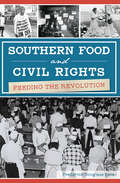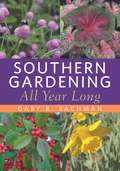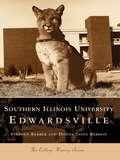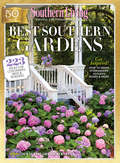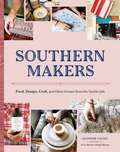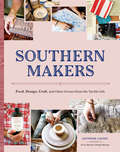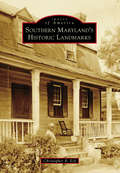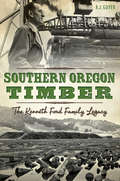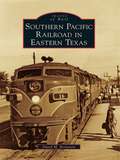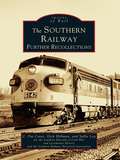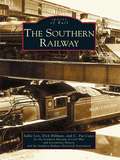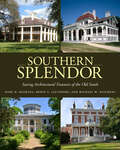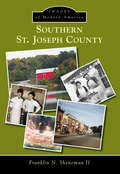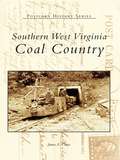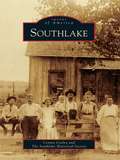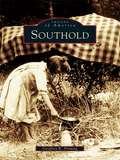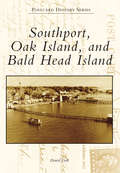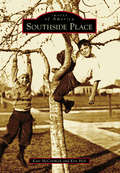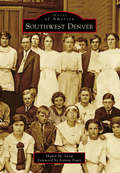- Table View
- List View
Southern Arkansas University: The Mulerider School's Centennial History, 1909-2009 (Campus History)
by Del Duke James F. WillisSouthern Arkansas University began as a residential agricultural high school, the Third District Agricultural School, in 1909. The school evolved into a junior college, popularly known as Magnolia A&M College, and later into a four-year institution, Southern State College. These four institutions served, primarily, young people of southwest Arkansas and provided extraordinary support to students, often the first in their families to seek degrees. The schools’ educational value has been exceptional, as measured in graduates’ achievements. Distinguished graduates have included, among many others, Gen. Horace Wade, ’36, vice chief of staff, US Air Force; Leland Tollett, ’56, president of Tyson Foods; Harry Thomason, ’62, Hollywood producer and director; Cinda Hallman, ’66, CEO, Spherion Corporation; Joyce Elliot, ’73, Arkansas state senator and educational reformer; Joan Dempsey, ’81, deputy director, US Central Intelligence Agency; and Fernando Barbosa, ’92, managing director, Walt Disney Television International.
Southern California Surf Music, 1960-1966
by John BlairDick Dale & the Del-Tones began holding weekend dances at the Rendezvous Ballroom in Balboa, California, in the summer of 1960. Over the next year and a half, Dale developed the sound and style that came to be known as "surf music." The result was the development of more powerful guitar amplifiers, a dramatic increase in the sales of Fender guitars and amplifiers, and a shift from New York to West Coast recording studios. More and more people were drawn to the sport of surfing, which became an important part of teen beach culture at the time. Even landlocked teenagers were captured by the moment, carrying surfboards atop their woodies in Phoenix or bleaching their hair blonde in St. Paul. For hundreds of thousands of kids, though, the attraction was not the connection to surfing; it was the connection to the music pioneered by Dick Dale.
Southern Colorado: O.T. Davis Collection (Images of America)
by Mike Butler Monte Vista Historical SocietyWhen the Denver & Rio Grande Railroad laid narrow-gauge tracks into La Veta in southern Colorado in July 1876, it preceded Colorado statehood on August 1 by about one month. The southern Colorado frontier from Walsenburg west to Wolf Creek Pass had only a few scattered villages at this time, but silver mines in southwestern Colorado lured the railroad ever westward to haul out the riches. On the scene to photograph these developments was Iowan Ory Thomas (O.T.) Davis, who moved to Colorado in 1885 to work in the copper mines northwest of La Veta. Davis, backed by corporate sponsors from the mines and railroads, opened a commercial photography business in the Walsenburg-La Veta area in 1888 and, later, in Alamosa in 1906. The photographs of O.T. Davis collected in this book vividly capture a bygone era, documenting the frontier history of southern Colorado in the early years of statehood.
Southern Cultures: The Photography Issue
by Harry L. Watson Jocelyn NealThe Cruel Radiance of the Obvious, The 2011 Photography IssueTom Rankin, Guest EditorOur second Photography issue features full-color photographs by William Eggleston, William Christenberry, and much more.CONTENTSFront Porchby Harry L. Watson"It requires very special talent to make great photographs, and those who have it are among our finest artists."The Cruel Radiance of the Obviousby Tom Rankin"Photography in its finest and most decisive moments is about those tired or ignored or unseen parts of our lives, the mundane and worn paths that sit before us so firmly that we cease to notice. It is, we might say, about rebuilding our sight in the face of blindness, of recovering our collective vision."American Studiesby Michael Carlebach"Many years ago I concluded that for me truth and beauty, and perhaps wit and wisdom as well, are more likely to reside in what is ordinary and seemingly insignificant. This is, perhaps, a sideways look at America and American culture, but it is one that can produce moments that describe us all, but without makeup and bereft of a spokesperson."Mapping The Democratic ForestThe Postsouthern Spaces of William Egglestonby Ben Child"When the color photographs of William Eggleston first appeared at the Museum of Modern Art in 1976, the boldness of Eggleston's palette and his disregard for the conventions of black-and-white photography were shocking; nearly all the major critics were scornful, and Ansel Adams wrote a scathing letter of protest."Stereo Propagandaby Lynn Marshall-Linnemeier"In this examination, magic and myth-two of my favorite vehicles-act as buffers to the dominant power structure. It brings together two bodies of collectibles, one personal and one commercial, with the intent of shifting stereotypes about race and southern culture."Interview"Those little color snapshots": William Christenberryinterviewed by William R. Ferris"Santa Claus had brought me and my sister a small Brownie camera in the late 1940s, and I just loaded it with color film and went out to that Alabama landscape and began to photograph what caught my eye."Heroes of Hell Hole SwampPhotographs of South Carolina Midwives by Hansel Mieth and W. Eugene Smithby Dolores Flamiano"Mieth and Smith shared a belief that photography could bring social change. They viewed Pat Clark and Maude Callen as heroic healers whose stories would inspire racial understanding. Both photographers shot powerful images of the most visceral human experiences: birth, death, sexuality, and disease."Women Workingby Susan Harbage Page"'Rough. It is rough being a female.'"Not ForgottenThe Day Is Past and GoneFamily Photographs from Eastern North CarolinaBy Scott Matthews"'It is in fact hard to get the camera to tell the truth; yet it can be made to, in many ways and on many levels. Some of the best photographs we are ever likely to see are innocent domestic snapshots.'"All eight articles from this issue of Southern Cultures are also available individually as stand-alone ebooks.
Southern Food and Civil Rights: Feeding the Revolution (American Palate Ser.)
by Frederick Douglass OpieFood has been and continues to be an essential part of any movement for progressive change. From home cooks and professional chefs to local eateries and bakeries, food has helped activists continue marching for change for generations. Paschal's restaurant in Atlanta provided safety and comfort food for civil rights leaders. Elijah Muhammad and the Nation of Islam operated their own farms, dairies and bakeries in the 1960s. "The Sandwich Brigade" organized efforts to feed the thousands at the March on Washington. Author Fred Opie details the ways southern food nourished the fight for freedom, along with cherished recipes associated with the era.
Southern Gardening All Year Long
by Gary R. BachmanSouthern Gardening All Year Long approaches southern landscapes from a different perspective. Instead of encyclopedic lists and articles focused on botanical gardens or someone else’s landscape, author and host of Southern Gardening Gary R. Bachman connects with his audience through personal stories that share his expertise gained over decades of planting, all told in an easily digestible format. Most stories in Southern Gardening All Year Long focus on Bachman’s hands-on experience with gardening. He recounts tales about his own personal gardens—plants that have thrived and failed—and presents his advice in a common-sense style. Bachman's personal, conversational writing makes Southern Gardening All Year Long an old-fashioned, over-the-fence chat with a knowledgeable and helpful neighbor. Just as he has done in newspapers, and on television and radio, with Southern Gardening All Year Long, Bachman hopes to help gardeners be successful in their own landscapes, alleviate some of the apprehension new gardeners feel, and inspire experienced gardeners to try new plants instead of the same old plantings every year. Gardening success doesn’t always follow steps 1-2-3, but Bachman encourages readers not to worry about plants that don’t survive. Failures happen in gardens every season. Offering a variety of tips and tricks and over 170 color images, Southern Gardening All Year Long will become a gardener’s best friend.
Southern Illinois University Edwardsville
by Donna Yates Bardon Stephen KerberFor many years the residents of Southwestern Illinois lacked convenient, affordable access to higher education. To address this situation, Southern Illinois University opened residence centers at the former Shurtleff College in Alton and in East St. Louis in 1957. Enrollment at the two residence centers during 1957-1958 exceeded all expectations, and continued to increase dramatically. In 1960, Illinois voters approved a statewide Universities Bond Issue that included $25 million designated for an Edwardsville campus of SIU. Situated on 2,600 acres of Illinois hills northeast of St. Louis, and featuring buildings designed by architect Gyo Obata, the beautiful campus opened in September of 1965. Within five years, enrollment surpassed 13,000. Since 1957, SIUE has become the largest university in the St. Louis metropolitan area, and has produced more than 70,000 graduates. The university today offers 83 degree programs to students enrolled in the College of Arts and Sciences and the Schools of Business, Engineering, Dental Medicine, Nursing, and Education.
Southern Living: 223 Ideas for Containers, Beds & Borders
by The Editors of Southern LivingIn honor of Southern Living's 50th anniversary, we present our best-ever collection of gardening ideas and advice, from growing information for top Southern plants to tours of the South's most beautiful gardens.
Southern Makers
by Jennifer CauseyIn this follow-up to our bestselling Brooklyn Makers, photographer Jennifer Causey returns to her Southern roots to introduce us to a group of artisans with a long tradition of craftsmanship and a wonderfully vibrant cultural history. In communities across the South, amidst breathtaking country landscapes and bustling city neighborhoods, a thriving creative revival is underway. In Southern Makers, Causey captures the spirit of this movement by documenting twenty-five of the area's most celebrated craftspeople. This eclectic mix of established and up-and-coming makers includes bakers, textile artists, denim designers, jewelers, woodworkers, brewers, farmers, and more. Causey's photographs are suffused with Southern charm as she explores the artisans' spaces, from restored homes and old factories to repurposed gas stations, general stores, and flowering fields. These lively interviews reveal personal inspirations and motivations, along with heartfelt reflections on the place where they live and work.
Southern Makers: Food, Design, Craft, and Other Scenes from the Tactile Life
by Jennifer CauseyIn this follow-up to our bestselling Brooklyn Makers, photographer Jennifer Causey returns to her Southern roots to introduce us to a group of artisans with a long tradition of craftsmanship and a wonderfully vibrant cultural history. In communities across the South, amidst breathtaking country landscapes and bustling city neighborhoods, a thriving creative revival is underway. In Southern Makers, Causey captures the spirit of this movement by documenting twenty-five of the area's most celebrated craftspeople. This eclectic mix of established and up-and-coming makers includes bakers, textile artists, denim designers, jewelers, woodworkers, brewers, farmers, and more. Causey's photographs are suffused with Southern charm as she explores the artisans' spaces, from restored homes and old factories to repurposed gas stations, general stores, and flowering fields. These lively interviews reveal personal inspirations and motivations, along with heartfelt reflections on the place where they live and work.
Southern Maryland's Historic Landmarks (Images of America)
by Christopher R. EckSouthern Maryland is made up of a collection of peninsulas covered in low rolling hills, fields, forests, swamps, and waterways leading to the Potomac River and the Chesapeake Bay. As such, this area enjoyed relative isolation and small population for over three centuries despite its proximity to cities such as Alexandria, Annapolis, Baltimore, and Washington. Those who did settle here developed a close connection to its farms, waterways, and natural remoteness. Southern Maryland, known for the state's earliest Colonial settlements, is composed of three of the state's oldest counties: St. Mary's, Charles, and Calvert. Although largely agricultural and maritime in outlook, this region was also the birthplace of the nation's ideal of religious freedom and many of its greatest citizens, including leaders of the Revolution, the early national government, and the state. Many of their homes and churches survive as historic landmarks, or their existence has been documented and preserved for posterity.
Southern Oregon Timber: The Kenneth Ford Family Legacy (Transportation)
by R. J. GuyerForestry defined the culture of southern Oregon. Kenneth and Hallie Ford rose from humble beginnings with a single sawmill during the Great Depression and helped transform the state's timber industry. They founded one of the largest privately owned wood-products companies in the country, bringing the title "Timber Capital of the Nation" to Roseburg, Oregon. Their legacy remains today through the Ford Family Foundation, dedicated to educational grants and community improvements. Author R.J. Guyer explores the evolution of logging and the challenges faced by the hearty men and women who plied this trade.
Southern Pacific Railroad in Eastern Texas
by David M. BernsteinThe Southern Pacific Railroad and its predecessors served Texas from 1853 to 1996. Stretching from El Paso to the Louisiana border and from the Rio Grande Valley to the Red River, Southern Pacific opened up vast areas of the state to settlement by transporting people, building materials, and livestock. The railroad fueled Texas's economy by moving oil, timber, agricultural commodities, coal, automobiles, petrochemicals, cement, steel, consumer goods, and myriad other products. It hauled the marble that built the state capitol in Austin and the materials to build the massive seawall in Galveston. Southern Pacific also played an important role in developing the ports of Beaumont, Galveston, Houston, and Corpus Christi. This book is a photographic record of Southern Pacific in eastern Texas during the 50-year period following World War II to the 1996 merger with the Union Pacific Railroad.
Southern Railway, The: Further Recollections
by Dick Hillman C. Pat Cates Sallie Loy Southern Museum of Civil War and Locomotive History Southern Railway Historical AssociationFollowing on the heels of Images of Rail: The Southern Railway, this volume takes a more detailed look at a historic railroad that has served the South for over 100 years and continues to serve as the Norfolk Southern Railway. Included in these pages are stories of bravery in war andingenuity in peace. From 1942 to 1945, the 727th Railway Operating Battalion--sponsored by the Southern Railway--served in North Africa and up the spine of Italy into Germany. The courageous unit received a citation from Gen. George S. Patton for its involvement in the Sicily Campaign.
Southern Railway, The: Further Recollections (Images of Rail)
by Dick Hillman Southern Railway Historical Assocuiation C. Pat Cates Sallie Loy Southern Museum of Civil War and Locomotive HistoryThe Southern Railway was the pinnacle of rail service in the South for nearly 100 years. Its roots stretch back to 1827, when the South Carolina Canal & Rail Road Company was founded in Charleston to provide freight transportation and America's first regularly scheduled passenger service. Through the Civil War, Reconstruction, and the Great Depression, rail lines throughout the South continued to merge, connecting Washington, D.C. to Atlanta and Charleston to Memphis. The Southern Railway was born in 1893 at the height of these mergers. It came to an end in 1982, merging with Norfolk and Western Railway to become Norfolk Southern Railway. The history of the railway lives on, however, and Norfolk Southern continues to "serve the South." In 2003, the Southern Railway Historical Association selected the Southern Museum of Civil War and Locomotive History as the repository for their extensive archives. Included in this collection are hundreds of professional quality, black-and-white photographs taken by company photographers throughout the railway's history. These photographs not only capture the transition from steam to diesel and the pinnacle of rail travel, but also the development of the South through much of the 20th century. While a few of these images have been seen by the public, the vast majority have not.
Southern Splendor: Saving Architectural Treasures of the Old South
by Marc R. Matrana Robin S. Lattimore Michael W. KitchensFew things evoke thoughts and memories of the past more than a house from a bygone era, and few places are identified and symbolized more by historic dwellings than the American South. Plantation houses built with columned porticos and wide porches, stout chimneys, large rooms, and sweeping staircases survive as legacies of both a storied and troubled past. These homes are at the heart of a complex web of human relationships that have shaped the social and cultural heritage of the region for generations. Despite their commanding appearance, the region's plantation houses have proven to be fragile relics of history, vulnerable to decay, neglect, and loss. Today, only a small percentage of the South's antebellum treasures survive. In Southern Splendor: Saving Architectural Treasures of the Old South, historians Marc R. Matrana, Robin S. Lattimore, and Michael W. Kitchens explore almost fifty houses built before the Civil War that have been authentically restored or preserved. Methodically examined are restoration efforts that preserve not only homes and other structures, but also the stories of those living in or occupying those homes. The authors discuss the challenges facing specific plantation homes and their preservation. Featuring over 275 stunning photographs, as well as dozens of firsthand accounts and interviews with those involved in the preservation of these historic properties, Southern Splendor describes the leading role the South has played, since the nineteenth century, in the historic preservation movement in this country.
Southern St. Joseph County (Images of Modern America)
by Franklin N. Sheneman IIThe changing world of the 1960s forced adaptation upon southern St. Joseph County, which was still trying to retain a rural identity in the towns of North Liberty, Walkerton, and Lakeville. By the decade's end, Studebaker had closed, and multigenerational family farms had been sold to accommodate the creation of Potato Creek State Park. The early 1980s brought further challenges for community leaders tasked with consolidating area schools to form the John Glenn School Corporation. Through all of this, the community retained its steadfast commitment to fellowship and local charm. Festivals, parades, church gatherings, and school activities reinforce what it means to be a Hoosier in southern St. Joseph County.
Southern Steam Recollections: A Portrait of the Last Years
by Don BennThis collection of historic photographs showcases the steam trains of England&’s Southern Railway from Devon and Cornwall to Wimbledon and beyond. Train enthusiast Don Benn photographed steam locomotives along England&’s Southern Railway from 1960 until steam engines were retired in 1967. In his most prolific years, between 1961 and 1963, Benn captured the last of the classic ex Southern Railway designs, such as the King Arthurs, Lord Nelson and Schools classes. Beloved trains such as the Bournemouth Belle and Lymington Pier boat trains are shown to good effect. The 150 black and white photos presented in this volume, many published here for the first time, span the Southern Region from the east to the &‘withered arm&’ in Devon and Cornwall. Special focus is paid to the areas just south and south west of London, including such historic locations as the footpaths at South Croydon and Wimbledon.
Southern Steam Recollections: A Portrait of the Last Years
by Don BennThis collection of historic photographs showcases the steam trains of England&’s Southern Railway from Devon and Cornwall to Wimbledon and beyond. Train enthusiast Don Benn photographed steam locomotives along England&’s Southern Railway from 1960 until steam engines were retired in 1967. In his most prolific years, between 1961 and 1963, Benn captured the last of the classic ex Southern Railway designs, such as the King Arthurs, Lord Nelson and Schools classes. Beloved trains such as the Bournemouth Belle and Lymington Pier boat trains are shown to good effect. The 150 black and white photos presented in this volume, many published here for the first time, span the Southern Region from the east to the &‘withered arm&’ in Devon and Cornwall. Special focus is paid to the areas just south and south west of London, including such historic locations as the footpaths at South Croydon and Wimbledon.
Southern West Virginia: Coal Country (Postcard History Series)
by James E. CastoCoal was mined in Southern West Virginia even before the state's birth in 1863 but was mostly consumed within a few miles of where it was dug. When the railroads arrived on the scene, they not only provided a means of getting that coal to market, they also brought in trainloads of workers to the sparsely populated region. With the mines generally located in remote, out-of-the-way spots, operators were forced to build housing for those workers and their families, as well as company stores, schools, and churches- everything needed in a small community. Overnight, the nation's demand for coal turned sleepy, little places in Southern West Virginia into boomtowns and helped cities such as Charleston and Huntington grow and prosper as gateways to and from the coalfields.
Southlake
by The Southlake Historical Society Connie CooleyOf the settlers who journeyed to North Texas 165 years ago, 12 families from Missouri traveled in oxen-drawn wagons to the Eastern Cross Timbers. These families laid claim to land in Peters Colony that was promised by the Republic of Texas's first empresario. The hardscrabble colonists built log cabins and the Lonesome Dove Church, the first church in Tarrant County. Their village came to be called Dove. Later settlements included White's Chapel, Old Union, and Jellico. The Depression hit local farmers and cattlemen hard, and newspaper accounts tell of small-time outlaws passing through, including members of the infamous Bonnie and Clyde gang who shot and killed two state troopers near Texas Highway 114. In 1956, a handful of neighbors voted to incorporate, and the town of Southlake was born. A decade later, city leaders from nearby Dallas and Fort Worth agreed to the construction of a regional airport east of Southlake, and the Dallas-Fort Worth Airport brought many families and prosperity to an area that flourishes today.
Southold
by Geoffrey K. FlemingOut on the North Fork of Long Island, Southold claims to be the oldest English settlement in New York State, with Europeans arriving here prior to 1640. This first photographic history of Southold contains striking images dating from the mid-nineteenth century through the mid-twentieth century. Southold portrays the people, events, buildings, and places that shaped this thriving community, which today is a popular tourist destination noted for its rich farmland and beautiful beaches and, most recently, for the exceptional wines produced in the region.
Southport, Oak Island, and Bald Head Island (Postcard History Series)
by Daniel FinkSouthport, Oak Island, and Bald Head Island are coastal North Carolina communities. History abounds in this area, settled by the Smith brothers in the late 1700s. A century later, Fort Caswell was built on Oak Island and used for Confederate defense. Two of North Carolina's historic lighthouses grace the beaches of the area. "Old Baldy" was built in 1817 in a unique octagonal shape. On Oak Island, the lighthouse is modern yet beautiful; it was completed in 1958. River steamer routes flowed through here until 1925, exporting and importing goods at the Wilmington port. Today, the area is a popular destination for tourists who enjoy the plentiful live oaks, fishing, the waterfront park of Southport, and the North Carolina Maritime Museum. Southport, Oak Island, and Bald Head Island showcases the rich military and recreational history of these coastal towns.
Southside Place (Images of America)
by Kris Holt Kate MccormickIn 1924, Edward Lilo Crain platted Southside Place, a 329-lot subdivision on the soggy prairie just west of bustling downtown Houston. Ahead of his time, Crain combined the roles of real estate investor, developer, and builder, establishing Southside Place with prefabricated catalog homes. The neighborhood's most defining attribute, however, is the 1.5-acre park Crain created as its geographic and civic center. This thoughtful early attempt at city planning made Southside Place the first Houston subdivision to provide a swimming pool, tennis court, clubhouse, and park for the private use of residents.
Southwest Denver (Images of America)
by Shawn M. Snow Jeanne FaatzIn 1900, the bucolic landscape that stretched for miles southwest of Denver was made up of truck farms, dairies, and ranches. While the separate town of Valverde would be absorbed by Denver in 1902, the countryside beyond was the domain of Arapahoe and Jefferson Counties. Isolated sentinels such as Loretto Heights and Fort Logan stood tall on the prairie. As happened in countless American cities, however, the abandonment of urban cores for new suburbs would radically change a rural way of life that had lasted for decades. With an aggressive annexation policy after World War II that helped to double Denver's land area in 30 years, the city set forth gobbling up these new subdivisions and former rural county lands. Some clamored to join Denver; others railed against the giant next door. A new sense of place was created in the process, not quite urban and not quite suburban. A proud heritage remains in the hearts of residents fortunate enough to have been brought into Southwest Denver before the annexation floodgates were permanently closed.
